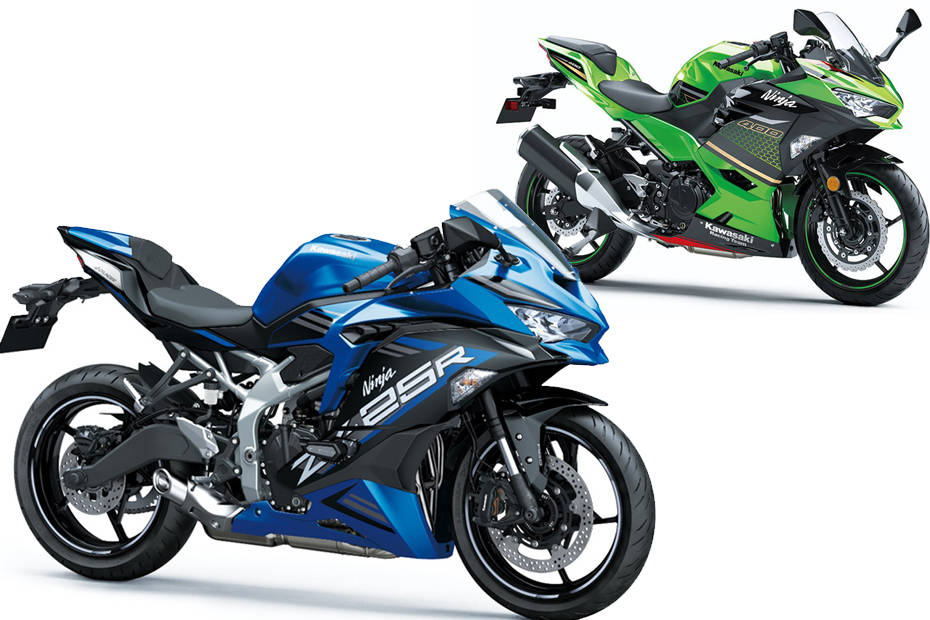Kawasaki ZX-25R vs Ninja 400: Image Comparison
Modified On July 20, 2020 17:24 IST
By Gaurav Sadanand
- 5375 Views
Two sportbikes from the same family catering to different market segments. Here’s a closer look at the differences in detailed images

Kawasaki recently introduced the ZX-25R for its international portfolio, which puts it in the same league as the Ninja 400. So you now have two bikes with different displacements and engine configurations catering to different market segments. But they’re priced quite similarly. Here's a closer look at the two bikes and their differences in detailed images.


No surprise here, the ZX-25R takes design cues from Kawasaki’s new design language that originated with the Ninja 400. However, it looks sharper, sleeker and more track-focused than the 400.


The front end with the massive ram-air intake flows into a lower-set handlebar, a chiselled fuel tank and a split seat setup that looks purpose-built for the tack. The Ninja 400, on the other hand, looks like a do-it-all machine with a relatively relaxed riding posture.


Both the bikes feature LED headlights and tail lights. The turn indicators, though, are conventional bulb-type units.


Even the analogue-digital consoles are pretty similar. However, the ZX-25R has a couple more functions like traction control and different power modes. It gets a keyless immobiliser in case of theft. Over and above the usual trove of information, both consoles display the estimated fuel range, gear position indicator and a clock.


Even the rearview mirrors are set lower according to the aggressive riding posture on the ZX-25R. The ones on the 400 are much taller in comparison.


Both the bikes feature a split seat setup, but the one on the ZX-25R looks better padded for the pillion as well as the rider.


The biggest distinction between the two bikes is the powertrain. The ZX-25R is powered by a 249cc inline four-cylinder that belts out 51PS at 15,500rpm and 22.9Nm of torque at 14,500rpm. The Ninja 400, on the contrary, makes a healthy 49PS of power at 10,000rpm, with 38Nm of peak torque kicking in at 8000rpm. Both sportbikes feature a 6-speed transmission; however, the ZX-25 in the top-spec SE trim gets a bi-directional quickshifter.


The chassis on the ZX-25 is all-new as well. The trellis frame on the Ninja 400 is equally impressive and exudes confidence.


Fuel tank capacity on the ZX-25R stands at 15-litres as opposed to 14-litres on the 400.


In terms of hardware, the ZX-25R uses premium separate function big piston USD forks (SFF-BP) and a horizontal back-link preload-adjustable monoshock. The Ninja 400 gets a 41mm telescopic fork and a preload-adjustable monoshock.


Anchoring the quarter-litre Kwacker is a single 310mm disc clamped by a radially-mounted four-pot monobloc caliper up front and a 220mm rear disc brake. The ZX-25R SE gets dual-channel ABS. Its sibling features the same disc dimensions but uses a lower-spec twin-pot axially-mounted caliper.
Also Read: Radial vs Axial Calipers: Differences Explained


The tyre dimensions are identical as well, with the only difference being make and compound. The ZX-25R, for instance, features stickier Dunlop GPR300 radial tyres while the 400 gets Dunlop Sportmax rubber.


The ZX-25 uses a premium cast aluminium swingarm while the Ninja 400 comes equipped with a box-section swingarm.


What tips the scale in favour of the Ninja 400 is its weight. The entire package weighs in at 173kg as opposed to the ZX-25R which weighs 182kg kerb.

Coming to the price of the bikes. The ZX-25R is available in two variants: Standard and Special Edition, priced at IDR 96,000,000 (Rs 4.99 lakh) and IDR 112,900,000 (approximately Rs 5.87 lakh) on-road respectively. As for the Ninja 400, it retails at Rs 4.99 lakh (ex-showroom) in India.
